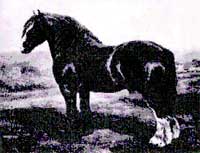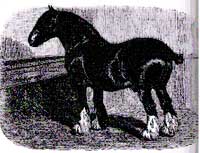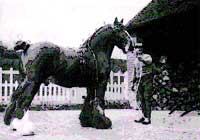| |
.: Shires Past and Present
.: From the Great Horse to the Shire
.: Packington Blind Horse
.: The Stud Book
.: The Contemporary Shire
.: Origins of the Shire
Shires
Past and Present
 The
Shire horse breed originated in England, particularly in the Fen
district of East Anglia and in Leicestershire, Staffordshire, Derbyshire
and Lincolnshire. The breed dates back to the big English horse
of the Middle Ages, known as the Great Horse, which in turn derives
from the heavy horses brought to England following the Norman Conquest.
These continental horses were descendants of the primitive forest
horse. The
Shire horse breed originated in England, particularly in the Fen
district of East Anglia and in Leicestershire, Staffordshire, Derbyshire
and Lincolnshire. The breed dates back to the big English horse
of the Middle Ages, known as the Great Horse, which in turn derives
from the heavy horses brought to England following the Norman Conquest.
These continental horses were descendants of the primitive forest
horse.
(into photo: Harold (1881-1901))
From
the Great Horse to the Shire
.
Judging by the accoutrement used in the 16th century, what is now
known as the Great Horse was actually a cob type of animal standing
about 16hh (160 cm) at the withers. It had little in common with
 today´s Shire. The Great Horse was of no practical use in
England until the late 16th century when these large, heavy beasts
were no longer needed to carry knights in armour. They were now
put to work hauling heavy wagons along country lanes that were no
more than wheel tracks, hard as stone in the Summer, deep and muddy
during in wintertime.
today´s Shire. The Great Horse was of no practical use in
England until the late 16th century when these large, heavy beasts
were no longer needed to carry knights in armour. They were now
put to work hauling heavy wagons along country lanes that were no
more than wheel tracks, hard as stone in the Summer, deep and muddy
during in wintertime.
The Friesian and Flanders breeds also played an important part in
the development of the Shire. The Friesian refined the breed and
gave it an easier gait, but it was the Flanders horse (mainly black,
like the Friesian) that contributed most to the Shire´s development.
The Flanders horse came to England with the Dutch contract workers
who drained the Fenlands of East Anglia in the early 17th century.
When the land reclamation was complete, this horse breed remained
and was reared locally. From that time onward the Great Horse of
England is not mentioned. Instead, the English Cart Horse became
known as the English Black, so-called by none other than Oliver
Cromwell, who hailed from Cambridgeshire and was a well-known agricultural
expert. Probably he was referring to the Friesian horse, but the
name English Black survived and is still used.
(into photo: Hitchin Conqueror)
Packington
Blind Horse
The Shire horse root stallion is believed to be the all black Blind
Horse of Packington village near Ashby de la Zouche in Leicestershire,
who lived from 1755 to 1770. He was referred to in the first edition
of the Cart Horse Stud Book, as he had sired so many horses!
The
Stud Book
 The first Shire horse society was The English Cart Horse Society,
founded in 1878 and the first Stud Book was published two years
later. The name of the organisation was changed in 1884 to The Shire
Horse Society. About five thousand animals were registered each
year from 1901 to 1914 and many were exported. After the Second
World War, however, there was little demand for the breed, either
in agriculture or in industry. One of the few areas where Shires
played a useful part was in the brewery trade where they made an
attractive advertising feature. Shires have enjoyed good publicity
at shows round the year in all parts of Britain. The best known
of these is the world´s biggest, Peterborough Show, Cambridgeshire.
The first Shire horse society was The English Cart Horse Society,
founded in 1878 and the first Stud Book was published two years
later. The name of the organisation was changed in 1884 to The Shire
Horse Society. About five thousand animals were registered each
year from 1901 to 1914 and many were exported. After the Second
World War, however, there was little demand for the breed, either
in agriculture or in industry. One of the few areas where Shires
played a useful part was in the brewery trade where they made an
attractive advertising feature. Shires have enjoyed good publicity
at shows round the year in all parts of Britain. The best known
of these is the world´s biggest, Peterborough Show, Cambridgeshire.
(into photo: Halstead Royal Duke, champion at London
into 1909)
The
Contemporary Shire
Today’s Shire Horse differs from those of the 19th and early
20th centuries. Today’s Shire is not so heavy and stocky.
In those days there were two different classes at horse shows, one
for smaller stallions and one for larger. A stallion standing 17.3
hh (1.80cm) was very unusual. Nowadays the Shire does not have so
heavy a frame, and its feather is not so bushy. The latter was reduced
by breeding in an attempt to deal with grease and coarse limbs.
It was achieved by, among other things, crossing the Shire with
the Clydesdale, and at the same time refining the heavy skeleton,
which produced a more slender-limbed horse. Today’s Shire
is taller and has longer legs than its predecessors. Their enormous
strength is manifested by their numerous hauling records. At the
Wembley Exhibition in 1924 a pair of Shires were pitted against
a dynomometer (an instrument for measuring tractive effort), but
the instrument´s range was insufficient and the arrangers
of the trial estimated that the horses had exerted a tractive effort
of 50 tons. The same pair, driven in tandem on a slippery stone
track, hauled 18½ tons; the rear horse started to pull before
the lead horse had even been coupled up! Black with white legs is
still the most popular colour for the Shire, greys are fairly common,
but the most common of all are brown and bay.
Origins of the
Shire
Breeding of the huge Shire horse is, of tradition, concentrated
to the Midland counties of Leicestershire, Staffordshire and Derbyshire
(hence the name “Shire”) and also Lincolnshire and the
Fenlands, nearer the North Sea coast, where the heavier and bulkier
horse type originated. The work of draining the Fens during the
early 17th century played a large part in the origin of the Shire
breed. The Dutch contract workers brought their own massive, large-
footed horses with them. They were the only horses that could cope
with such heavy work on the soft soil. When the work was completed,
the horses were left behind and became the founders of today’s
Shire horse breed. |

 today´s Shire. The Great Horse was of no practical use in
England until the late 16th century when these large, heavy beasts
were no longer needed to carry knights in armour. They were now
put to work hauling heavy wagons along country lanes that were no
more than wheel tracks, hard as stone in the Summer, deep and muddy
during in wintertime.
today´s Shire. The Great Horse was of no practical use in
England until the late 16th century when these large, heavy beasts
were no longer needed to carry knights in armour. They were now
put to work hauling heavy wagons along country lanes that were no
more than wheel tracks, hard as stone in the Summer, deep and muddy
during in wintertime. The first Shire horse society was The English Cart Horse Society,
founded in 1878 and the first Stud Book was published two years
later. The name of the organisation was changed in 1884 to The Shire
Horse Society. About five thousand animals were registered each
year from 1901 to 1914 and many were exported. After the Second
World War, however, there was little demand for the breed, either
in agriculture or in industry. One of the few areas where Shires
played a useful part was in the brewery trade where they made an
attractive advertising feature. Shires have enjoyed good publicity
at shows round the year in all parts of Britain. The best known
of these is the world´s biggest, Peterborough Show, Cambridgeshire.
The first Shire horse society was The English Cart Horse Society,
founded in 1878 and the first Stud Book was published two years
later. The name of the organisation was changed in 1884 to The Shire
Horse Society. About five thousand animals were registered each
year from 1901 to 1914 and many were exported. After the Second
World War, however, there was little demand for the breed, either
in agriculture or in industry. One of the few areas where Shires
played a useful part was in the brewery trade where they made an
attractive advertising feature. Shires have enjoyed good publicity
at shows round the year in all parts of Britain. The best known
of these is the world´s biggest, Peterborough Show, Cambridgeshire.